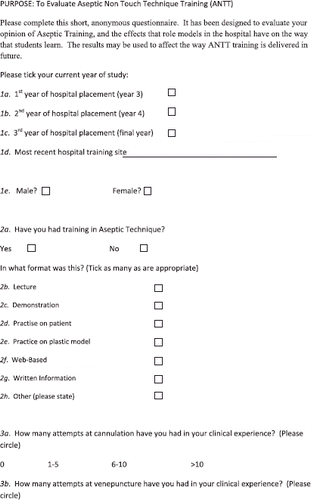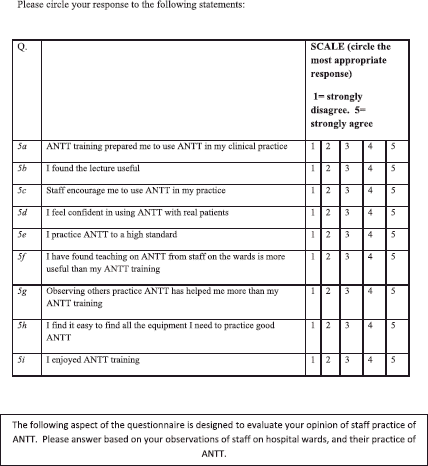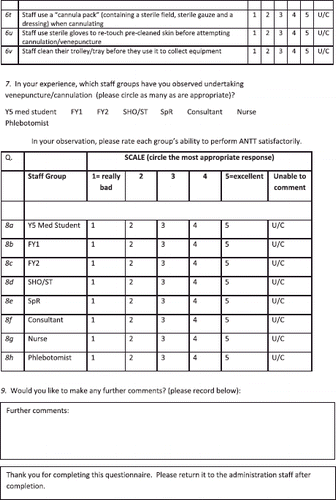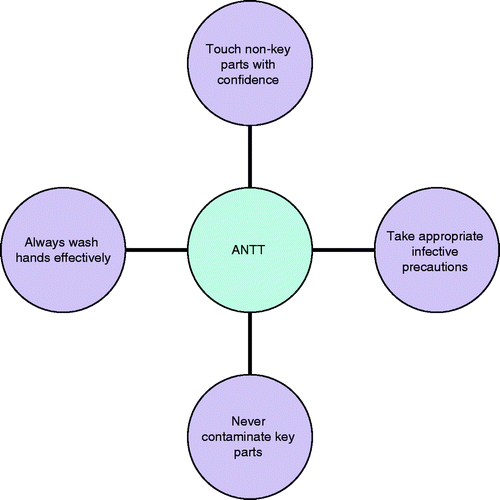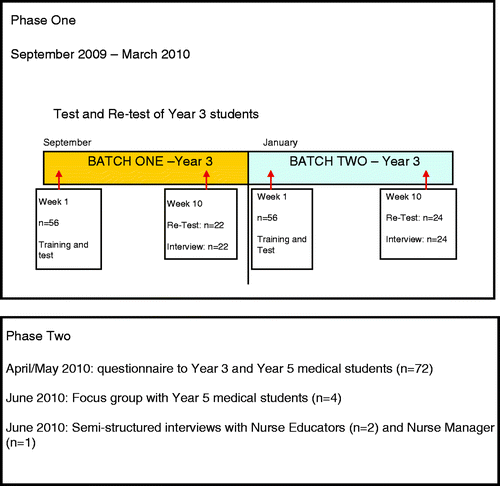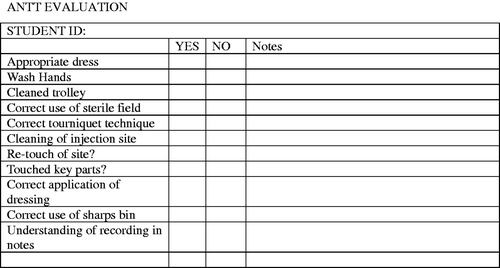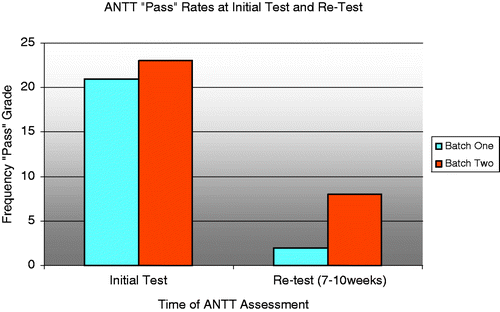Abstract
Background: Infection control in the hospital environment is a topical issue in the UK. Aseptic Non-Touch Technique (ANTT) has been recommended as an example of best practice for clinical skills requiring aseptic technique. ANTT is taught to clinical staff and to medical students at a West Midlands teaching hospital.
Aims: To determine the effectiveness of ANTT training within an undergraduate population and to explore the factors involved in medical students’ failure to learn this skill
Method: 132 Students underwent training and assessment in ANTT. A sample of 42 students underwent re-testing in ANTT 7–10 weeks later. Student questionnaires and semi-structured interviews with students and trainers were undertaken to determine students’ daily practice of ANTT, and practice observed in staff.
Results: Student performance deteriorated significantly 10 weeks after initial ANTT training (p < 0.001). Qualitative data demonstrates an emphasis on assessment, poor observed practice in staff, and a lack of resources in the clinical setting. Further themes include acceptance of hierarchy, and a lack of belief in ANTT amongst students.
Conclusion: In order to bring about effective training in ANTT, we must look to the sociocultural contribution of the hospital environment alongside formal ANTT training.
Introduction
Infection control in the hospital environment is a topical issue in the UK. A reduction in rates of healthcare associated infection (HCAI) is high on the National Health Service agenda, and this is highlighted both in the media and in government policy. Darzi (Citation2008) has emphasized the need to improve clinical behavior, and address practices such as basic hygiene and aseptic technique.
Despite these aims, little research is available on effective, evidence-based aseptic techniques. Much of hospital aseptic practice is anecdotal or ritualistic (Rowley Citation2001). In response to this, Aseptic Non-Touch Technique (ANTT) was developed as a guideline for practice in the aseptic technique and was recommended as an example of best practice in the aseptic technique (Pratt et al. Citation2007).
Formal ANTT training has been implemented at many NHS trusts in the UK (Rowley & Clare Citation2009). In addition to staff, ANTT training is often delivered to undergraduate medical students. Despite this training, I felt that my students were not learning ANTT.
The literature suggests that formal training is not the only way in which students learn. The complexity of a hospital environment means that medical students are exposed to multiple healthcare professionals and influences as they implement new skills. Hafferty (Citation1998) outlines this concept in his description of the curriculum triad, where formal, informal and the hidden curricula are considered. This study therefore aims to consider the multiple factors involved in medical students’ learning of ANTT.
Background
There are four cornerstones of ANTT, and these are outlined in
.It has been estimated that 150–250 NHS hospitals use ANTT as standard practice (Rowley & Clare Citation2009). In Rowley and Clare's (Citation2009) audit of ANTT training within seven trusts, five trusts demonstrated a positive improvement in rates of hospital-acquired infection. In this respect, evaluation of ANTT suggested it to be a tool capable of reaching the highest levels in the Kirkpatrick Hierarchy – changes to behavior and improvement in patient care (Kirkpatrick Citation1998).
In a large teaching hospital in Birmingham (the hospital in which this research project was undertaken), all staff and medical students at induction are trained and assessed on their understanding of ANTT. The training format involves a short lecture on the principles of ANTT, followed by a demonstration (on a model arm) of cannulation using ANTT. Trainees are then assessed on their ability to perform a cannulation using ANTT. If the trainee passes the assessment, it is expected that they are competent to perform ANTT in the clinical setting. However, this assumption may or may not be correct.
Rationale for study
There are clearly differences in the student and staff populations who receive ANTT training:
Many students (particularly Year 3 students) will not attempt practical procedures for weeks or months after their ANTT training, whereas staff members usually undertake clinical procedures regularly.
For clinical staff, a background of clinical practice or experience exists. In contrast, Year 3 students are unfamiliar with much of the equipment used in the training, and potentially with some of the terminology of the ANTT lecture and assessment.
In addition to the formal training format, the literature also suggests that the sociocultural environment contributes to medical student learning. As outlined by Hafferty (Citation1998), a multidimensional learning environment exists. He describes it as comprising of three spheres: the Formal (taught) Curriculum, the Informal Curriculum (learning that is largely ad hoc and interpersonal), and the Hidden Curriculum (influences that function at the level of organizational structure and culture). In light of these observations and reflections, the following research questions were raised:
Is the current ANTT training format effective for an undergraduate population?
What is the sociocultural contribution to student learning and practice of ANTT?
This project outlines an evaluation approach to answering these research questions.
Methods
The study was conducted in two phases (
):Phase 1:
Two cohorts of 56 students were trained in ANTT. 22 and 24 students were re-tested 7–10 weeks later. All 46 re-tested students were interviewed.
Phase 2:
72 students in Years 3 and 5 answered a 63-item questionnaire about attitudes and opinions relating to ANTT.
Interviews were conducted with two nurse educators and one nurse manager.
Interviews were conducted with four Year 5 students.
Phase 1
A cohort (n = 56) of Year 3 medical students were trained and assessed in ANTT on arrival to their placement at a single teaching hospital site. Students can “pass” or “fail” (and subsequently re-sit) their initial assessment.
A sample of this cohort underwent re-testing in ANTT (n = 22, Batch One). After the re-test, each student was interviewed and asked to comment on their daily practice of ANTT, and the practice they had observed in staff.
A second cohort (n = 56) of new students arrived for placement and underwent the same ANTT training and assessment. Seven to 10 weeks later, a sample was invited for re-test according to the same conditions as those used for Batch One (n = 24, Batch Two).
All available students were invited to participate. Students were not informed of the nature of the study until the time of re-test to avoid confounding of results in students who may revise the skill. Students on re-test were assessed in the same conditions, with the same assessment criteria as those used in the initial assessment (
).Analysis of test and re-test data
“Pass” and “Fail” rates were entered into SPSS. Pass rates on re-test were compared with secondary data gained from ANTT pass rates yielded at initial training. The McNemar test was used to compare the means for pass rates on initial and re-testing (Cohen et al. Citation2007).
Analysis of Phase 1 interview data
A pilot group of 10 students initially underwent re-testing and subsequent interview. These were conducted by a single researcher (DJ, Education Fellow). Responses were handwritten and key statements transcribed verbatim during interview. Data gained from the first 10 interviews were reviewed and emergent themes were listed. These then formed a template for the analysis of subsequent interviews, responses from which were recorded on a pro forma (Cohen et al. Citation2007). The data were analyzed using content and coding methods (Coffey & Atkinson Citation1996).
Phase 2
Questionnaires
A 63-item voluntary, anonymous questionnaire was distributed to medical students in Years 3 and 5 during the time of their end-of-year examinations. Responses were largely “tick box,” with opportunity to make free-text comments at the end of the survey (Cohen et al. Citation2007). The questions explored demographic details, with questions on attitudes and opinions on the teaching and practice of ANTT. It was piloted with another member of the research team and appropriate adjustments were made prior to distribution. The final questionnaire is included in the Appendix.
Semi-structured interviews
One-to-one interviews were undertaken with three members of staff at the teaching hospital used in Phase 1 of the study: two experienced nurse educators and a nurse manager (responsible for leading the ANTT training project at the hospital).
Interviews were undertaken by a single member of the research team (DJ, Education Fellow), and were recorded using a boundary microphone and dictaphone. Interviews were transcribed verbatim by the interviewer.
Group interview
All Year 5 students (senior students) at the teaching hospital were invited for group interview (n = 15). These students rotate through a number of hospitals during their training, and could therefore offer insight into training and practice elsewhere. Four students attended the interview.
Ethical considerations
Ethical approval was gained from the University Of Birmingham School of Education (the University responsible for the training of the main researcher in this project). Approval was also sought from the University at which the students were studying. This was to ensure that University staff were in agreement for their students to be invited to participate in the project.
If practices were detected in the project that potentially could compromise patient safety, correction and re-training was given to the student at the point of detection.
Results
Retention of ANTT skills
Batch One results: 21 of the 22 students passed their initial ANTT training assessment. Only two of the 22 students passed on re-testing at 10 weeks. This indicates a significant deterioration in scores (p < 0.001 using the McNemar test).
Batch Two results: 23 out of 24 students passed their initial assessment. Eight of the 24 students (33%) passed on re-testing. This again suggested significant deterioration in performance over time, with a p-value < 0.001(using the McNemar test;
).Phase 1ne – Interview data
All Year 3 participants agreed to interview (n = 46):
Use of ANTT in daily practice
46% of students felt they do not use all elements of ANTT in their daily practice (n = 21).
Table 1 Elements of ANTT neglected by students
Phase 2 – Questionnaire data
Seventy-two questionnaires were returned (response rate of 70.6%). Students had undergone ANTT training at a variety of training hospitals (10 in total).
Reliability
The reliability of questionnaire responses was assessed using Cronbach's alpha. This yielded a figure of 0.766 when all variables were considered.
Training in ANTT
Only seven students (9.7%) had not received formal training in ANTT at their training hospital. Most training formats involved lecture (n = 43) or demonstration (n = 50), with little patient-centered learning in the format of “patient practice” (n = 8) (
).(Student opinion of formal ANTT training
This was rated on a 5-point Likert scale. Responses on the whole were positive, with all aspects of formal training scoring a median of 3 or more.
Staff role modeling of ANTT
FY1 doctors were observed in every case by respondents (100%). Consultants were observed least, by only 22.5% of students.
Student perception of staff practice of ANTT
Students were asked to rate each role of staff on their use of ANTT on a Likert scale (1 = poor, 5 = excellent). Every staff role was rated favorably, with phlebotomists rated most highly (median = 5), and consultants least (median = 4). Elements felt most neglected by staff are outlined in
Table 2 Survey responses: elements of ANTT neglected by staff
Phase 2 – Thematic analysis
Interview data were used to illuminate and establish themes relating to ANTT training and practice. Key themes are outlined within this section.
Lack of belief in ANTT
This centered on doubts about its benefits and validity in clinical practice:
People say there are studies, but I’ve never seen any
(Year 5 undergraduate – Participant One)
I’m not sure if it's like a practical way. Well, the way we were shown, I’m not sure it's applicable to clinical practice.
(Year 5 undergraduate – Participant One)
Assessment driving learning
The experienced teacher described a focus on assessment, with students requesting revision sessions to improve their ANTT in procedures:
Although, I have to say this year, certainly I’ve noticed this time, they’ve [medical students] been really stressed out about their catheterisation. Because a lot of people have been failing on ANTT. Cos I’ve been doing some revision sessions for a few of them. And it's around ANTT and catheterisation. It was less about the actual procedure and more about, again, “what can we touch, what can’t we touch?
(Interview – Experienced teacher)
Surface learning
Students feel they need to learn a series of steps:
I always found it difficult because, it's probably just me, but I just feel there's so many different bits to it. It was always hard to remember.
(Year 5 Undergraduate – Participant One)
Students were not always afforded the opportunity of immediate application of ANTT training:
And if they’re not going out into practice and doing it, which most of them can’t, that's when they’re going to lose.
(Experienced Teacher)
Poor role-modeling of ANTT
It's probably not as good in practice as when you first get taught. I think as well because a lot of junior doctors that you’re doing it with often say like, “Oh, you don’t need to do that. Don’t bother doing that”.
Like wearing gloves. A lot of doctors don’t do that. They say, “Oh you don’t need that”.
(Year 5 undergraduate – Participant Two)
Lack of resources
Lack of trolleys, disposable tourniquets and sharps bins were cited most frequently:
They don’t have very many around actually on the ward [sharps bins], and they don’t have very many small ones, so nearly every time you don’t have a sharps bin.
(Year 5 undergraduate –Participant Two)
Acceptance of hierarchy
Students are influenced by a hospital hierarchy, and change practice based on instructions of more senior staff.
And then why would we argue with somebody who is above our station as to why we’re drying it for longer?
(Year 5 undergraduate – Participant Three)
Discussion
The results clearly demonstrate a significant deterioration in undergraduate performance in ANTT over time, with the majority of students failing the assessment just 10 weeks after their initial training. The task of the researcher was therefore to aim to determine why this might be the case. Potential factors that may be responsible can be considered by looking to the curriculum triad: the formal, informal and hidden ANTT curriculum (Hafferty Citation1998).
Formal curriculum
Students were largely positive about formal ANTT training, but were often not able to put their ANTT skills into practice after training. Whilst lectures and demonstrations may appeal to some, different types of learner do exist (Gardner Citation1983; Honey & Mumford Citation1987).
References to “steps” and “difficulty remembering” may suggest that the learners achieved only “surface learning” of ANTT following formal training (Marton & Saljo 1984 in Butt Citation2007).
The assessment used in formal training appeared to be adequate in assessing surface learning of ANTT. However, it did not assess deep learning, or whether students could use ANTT in the clinical environment.
If this is indeed the case, then both the teaching format and the assessments may be driving the learning.
From these comments, there may therefore be a case to consider a change to the timing of ANTT training, to allow students to immediately begin using their skills on the wards. In addition, changing the teaching to a ward-based, clinical setting may help with student engagement and make the skill feel more relevant to practice.
A change to the assessment could help trainees to focus on principles of ANTT, rather than “steps” and “surface learning”. However, a change to assessment should be viewed with caution. Miller (Citation1990) states that no single assessment of clinical practice is adequate. By simply replacing the current assessment, we may simply cause the learner to focus on a different aspect of ANTT, whilst neglecting another.
Informal curriculum
Undergraduate students frequently observe members of hospital staff performing ANTT, particularly FY1 Doctors. The impact of this observation on their practice of ANTT constitutes an aspect of the informal curriculum, and raises a number of questions. The first is whether the undergraduates are observing good practice, or bad practice. Based on questionnaire data, the undergraduate opinion seems to suggest that staff practice of ANTT is largely good. However, interview data suggests that students are also exposed to the observation of bad practice. Furthermore, they are, at times, directly instructed by staff to undertake poor practice. Variations in staff practice demonstrated in this study are in keeping with the variation demonstrated in Rowley and Clare's (Citation2009) evaluation of the implementation of ANTT across a number of trusts in the UK.
Although examples of poor practice and instruction have been given, the second question is to consider the impact of this on undergraduate performance. Certainly social constructivists such as Vygotsky (Citation1978) would suggest that observation of others within a community of practice would have a significant impact on the subsequent behavior of learners (Bonk & Cunningham Citation1998).
On interview, students cite examples of times when they have modified their practice based on the advice of staff, even if they know it to be wrong. A second noteworthy element is the fact that students and staff most frequently neglect the same element of ANTT: the use of clean surfaces to transport equipment. This may be related to a generic lack of resources, or coincidence. However, it may also relate to the fact that undergraduates are hugely influenced by what they observe in staff, and therefore modify their clinical practice to emulate the behavior they observe.
Hidden curriculum
Hafferty (Citation1998, p. 104) describes the Hidden Curriculum as:
A set of influences that function at the level of organisational structure and culture.
Results from this study indicate that students are exposed to elements of the Hidden Curriculum with regards to their learning of ANTT. The first of these is the apparent lack of resources, and the subsequent adaptation of ANTT of staff and students. These findings were also demonstrated in Rowley and Clare's (Citation2009) study of ANTT, and indicate a universal problem of a lack of tools to adequately undertake the procedure.
Lempp and Seale (Citation2004) found that medical undergraduates, as a result of the Hidden Curriculum, demonstrated a loss of idealism and acceptance of hierarchy. Interestingly, these themes were also strong in these data. Students and staff alike clearly demonstrate evidence of a lack of belief in ANTT, and in interviews, question its efficacy. However, during formal training, students were deemed to be enthusiastic and attentive. This change in attitude from enthusiasm to one of skepticism may be related to their exposure to the sociocultural setting within the hospital, and could represent the effect of the Hidden Curriculum. Students also appear to have an awareness of hierarchy within the hospital culture and, at times, accept this hierarchy.
Training students using the same resources as those available in the clinical context appears an obvious suggestion for change. However, this change in itself is unlikely to be sufficient. Within educational change, beliefs and understanding are seen to be foundations for achieving lasting reform (McLaughlin & Mitra Citation2001). Addressing the lack of belief in ANTT amongst students and staff appears to be fundamental to bringing about effective learning in ANTT.
Limitations of this study
The test and re-test method did not evaluate student's ability at all levels, such as the ability to synthesize their knowledge and skill in ANTT across a variety of clinical skills (Bloom Citation1956).
Methods in this study utilize the subjective reporting of students. This may introduce bias and questions relating to reliability. Multiple mixed methods were implemented to minimize this.
The group interview in this study was small – with just four students, all final year. It is recommended that the more group interviews, across year groups, should be undertaken.
Medical students from a single university provided opinion and observation of staff. These may not be generalizable elsewhere.
The key researcher in this study (DJ) was also responsible for the education of the students involved. Participants were informed of the voluntary and anonymous nature of the study at all occasions, but this may have led to bias or inconsistency in student responses.
Conclusion
ANTT training and its use in clinical practice appears to confer significant benefit to patients with reported reduction in the rates of MRSA in UK hospitals (Rowley & Clare Citation2009). It therefore appears to show benefit at the highest level of Kirkpatrick's Hierarchy, “Impact on Society” (Kirkpatrick Citation1998).
However, educational interventions such as ANTT training can be costly, requiring considerable financial, staff and time resources. Alongside patient outcomes, training ideally should demonstrate further benefits, such as educational impact, trainee satisfaction and a change to practice (Kirkpatrick Citation1998). This study has shown that undergraduate performance in ANTT deteriorates significantly 10 weeks after training. In addition, many undergraduates admit to modifying ANTT, or failing to use ANTT, in their daily clinical practice. This would suggest that training in ANTT amongst undergraduates is not entirely optimal, and may suggest that change is needed.
The literature states that educational change should be viewed objectively, and seen as multidimensional (Fullan Citation2007). With this viewpoint, it is possible to regard change objectively by “identifying and describing its main separate dimensions” (Fullan Citation2007, p. 29).
Within this study, problems with ANTT training have been demonstrated at formal, informal and hidden curricula levels. This suggests multifactorial reasons for the deterioration in student performance in ANTT.
It follows that changes to ANTT training should not be solely targeted at the “formal curriculum”. Teaching a skill without first considering the context in which it is to be practiced can lead to ineffective learning. By taking a multidimensional approach to changing this educational intervention, we can aim for true and deep educational reform.
Declaration of interest: The authors report no conflicts of interest. The authors alone are responsible for the content and writing of this article.
References
- Bloom B.S., (ed.). 1956. Taxonomy of educational objectives: The classification of educational goals. New York: McKay.
- Bonk CJ, Cunningham DJ. Searching for learner centred, constructivist and sociocultural components of collaborative educational learning tools. Electronic collaborators: Learner centred technologies for literacy, apprenticeship and discourse, CJ Bonk, KS King. Lawrence Erlbaum Associates Inc, New Jersey 1998; 32–34
- Butt G. “How do people learn?” Module one, day one, PGCert course. University of Birmingham, Birmingham 2007
- Coffey A, Atkinson P. Making sense of qualitative data. Sage, Thousand Oaks, CA 1996
- Cohen L, Manion L, Morrison K. Research methods in education6th. Routledge Falmer, London 2007
- Darzi A. High quality care for all. Crown Copyright, London 2008
- Fullan M. The new meaning of education change4th. Routledge, New York 2007
- Gardner H. Frames of mind: The theory of multiple intelligences. Basic Books, New York 1983
- Hafferty FW. Beyond curriculum reform: Confronting medicine's hidden curriculum. Acad Med 1998; 73(4)403–407
- Honey P, Mumford A. Using your learning styles. Peter Honey, Maidenhead 1987
- Kirkpatrick DL. Evaluating training programmes – The four levels 2nd ed. Berrett-Koehler Publishers, London 1998
- Lempp H, and Seale C. The hidden curriculum in undergraduate medical education: Qualitative study of medical students' perceptions of teaching. Br Med J 2004; 329: 770–773
- McLaughlin M, Mitra D. Theory-based change and change-based theory: Going deeper, going broader. J Educ Change 2001; 2(4)301–323
- Miller GE. The assessment of clinical skills/competence/performance. Acad Med 1990; 65(9)S63–S67
- Pratt RJ, Pellowe CM, Wilson JA, Loveday HP, Harper PJ, Jones SRLJ, McDougall C, Wilcox MH. Epic2: National evidence-based guidelines for preventing healthcare-associated infections in NHS hospitals in England. J Hosp Infect 2007; 65(1)S1–64
- Rowley S. Aseptic non-touch technique. Nurs Times 2001; 97(7)6
- Rowley S, Clare S. Improving standards of aseptic practice through an ANTT trust-wide implementation process: A matter of prioritisation and care. J Infect Prev 2009; 10(1)18–23
- Vygotsky L. Mind in society. Harvard University Press, London 1978
Appendix: Questionnaire
